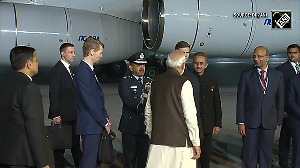 BIRLA SUN LIFE FRONTLINE EQUITY
BIRLA SUN LIFE FRONTLINE EQUITY
This one's a winner. If compared with the benchmark, it has had just one annual underperformance (2003) in seven years. From a relative point of view, it began to beat the category average only from 2006, a result of Patil taking over the fund in November 2005.
In 2009, it delivered 90.45 per cent (category average, 80.3 per cent). Its performance has not gone unnoticed. As assets under management (AUM) swelled, the outcome has been a more diversified portfolio, with around 60 stocks (up from 35 in January 2009). Since 2008, apart from RIL, Bharti Airtel and Infosys Technologies, no stock has accounted for more than five per cent of the portfolio.
This fund attempts to target the same sector weights in its portfolio, as is found in its benchmark BSE 200. But, that does not mean the fund manager is restricted to the benchmark universe.
His individual stock selection is totally flexible and there is some flexibility in computing the sector weights; either plus or minus 25 per cent of the weight in the index or an absolute figure of plus or minus 3 per cent, whichever is higher.
While Patil broadly adheres to this strategy, there have been the occasional deviations, such as energy and engineering in 2006 and 2007. "We have always been positive on capital goods, specially power equipment companies. This sector will continue to grow and the outlook is bright," says Patil. But, due to stretched valuations, he was underweight on energy at that time.
Though Patil is positive on mid caps, he ensures this fund has a large cap thrust. Higher than average returns, lower risk and a well diversified portfolio make it a sound proposition.
HDFC TOP 200
We like this fund for its solid long-term record and skilled management. With a five-year annualised return of 27 per cent, it is the best performer in its category (February 28, 2010).
In 2006 and 2007, investors fretted at the average performances. In 2006, it was the high exposure to defensives that pulled it down. In 2007, energy was offloaded even when the going was good, while exposure to financials did not impact as much as metals and construction, where the fund's exposure was low.
In 2008, the fund's success in standing upright in a bear market, without resorting to debt or high cash levels, was a testimony to Jain's skill, who restricted the fall to just 45 per cent, around 11 per cent less than BSE 200 and eight per cent lower than the category average.
Finally in 2009, Jain silenced critics by beating the category average by a margin of 14 per cent. Low cash levels, being overweight in autos and banking and underweight in power utilities and energy (reduced exposure significantly to RIL, which underperformed the broader market) helped.
The fund manager even has the liberty to in unlisted companies that would qualify to be in the top 200 by market capitalisation on the BSE.
Investors can be sure of a good-quality portfolio and a fund manager who sticks by his convictions, irrespective of whoever else is playing the momentum game.""We invest in good quality businesses, keep away from richly valued investments to the extent feasible and remain diversified," says Jain.
UTI OPPORTUNITIES
The fund has accomplished what it stated it would do and has made money for its investors. Launched in July 2005, it got off to a weak start. It delivered a meagre 11 per cent in 2006, underperforming both, its category and benchmark by huge margins.
But, come 2007, the fund began to make up for lost ground. Upadhyay took over in March 2007 and since then, the fund's performance has been more than impressive. Over the three-year period ended February 28, 2010, it was the best performing fund in its category, with an annualised return of 20 per cent, double its benchmark (10.3 per cent) and category average (10.32 per cent).
The mandate of this fund requires Upadhyaya to dynamically shift between sectors, depending on the macro economic outlook and opportunities available in the market.
By and large, Upadhyaya attempts to keep around 65-75 per cent of his portfolio in four to five select sectors, which he believes will outperform the broader market in the short to medium term. He also sticks to a 70 per cent large-cap tilt and averages at around 40 stocks in the portfolio.
The high cash levels in the fund don't imply he is not fully invested but indicate derivative exposures. "We employ derivatives either to hedge part of the portfolio or employ it for reverse arbitrage trades. Also, entry and exit is easier in the futures market because of high liquidity," says Upadhyaya.






